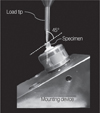1. Stockton LW. Factors affecting retention of post systems: a literature review. J Prosthet Dent. 1999; 81:380–385.


2. Qualtrough AJ, Mannocci F. Tooth-colored post systems: a review. Oper Dent. 2003; 28:86–91.

3. Ferrari M, Vichi A, García-Godoy F. Clinical evaluation of fiber-reinforced epoxy resin posts and cast post and cores. Am J Dent. 2000; 13:15B–18B.
4. Ferrari M, Vichi A, Mannocci F, Mason PN. Retrospective study of the clinical performance of fiber posts. Am J Dent. 2000; 13:9B–13B.
5. Hayashi M, Takahashi Y, Imazato S, Ebisu S. Fracture resistance of pulpless teeth restored with post-cores and crowns. Dent Mater. 2006; 22:477–485.


6. Hu YH, Pang LC, Hsu CC, Lau YH. Fracture resistance of endodontically treated anterior teeth restored with four postand-core systems. Quintessence Int. 2003; 34:349–353.

7. Komada W, Miura H, Okada D, Yoshida K. Study on the fracture strength of root reconstructed with post and core: alveolar bone resorbed case. Dent Mater J. 2006; 25:177–182.


8. Okada D, Miura H, Suzuki C, Komada W, Shin C, Yamamoto M, Masuoka D. Stress distribution in roots restored with different types of post systems with composite resin. Dent Mater J. 2008; 27:605–611.


9. Fuhrmann G, Steiner M, Freitag-Wolf S, Kern M. Resin bonding to three types of polyaryletherketones (PAEKs)-durability and influence of surface conditioning. Dent Mater. 2014; 30:357–363.


10. Stawarczyk B, Jordan P, Schmidlin PR, Roos M, Eichberger M, Gernet W, Keul C. PEEK surface treatment effects on tensile bond strength to veneering resins. J Prosthet Dent. 2014; 112:1278–1288.


11. Hayashi M, Sugeta A, Takahashi Y, Imazato S, Ebisu S. Static and fatigue fracture resistances of pulpless teeth restored with post-cores. Dent Mater. 2008; 24:1178–1186.


12. Ko CC, Chu CS, Chung KH, Lee MC. Effects of posts on dentin stress distribution in pulpless teeth. J Prosthet Dent. 1992; 68:421–427.


13. Kern M, Douglas WH, Fechtig T, Strub JR, DeLong R. Fracture strength of all-porcelain, resin-bonded bridges after testing in an artificial oral environment. J Dent. 1993; 21:117–121.


14. Schwartz RS, Robbins JW. Post placement and restoration of endodontically treated teeth: a literature review. J Endod. 2004; 30:289–301.


15. Lee KS, Shin JH, Kim JE, Kim JH, Lee WC, Shin SW, Lee JY. Biomechanical evaluation of a tooth restored with high performance polymer PEKK post-core system: A 3D finite element analysis. Biomed Res Int. 2017; 2017:1373127.







 PDF
PDF ePub
ePub Citation
Citation Print
Print







 XML Download
XML Download